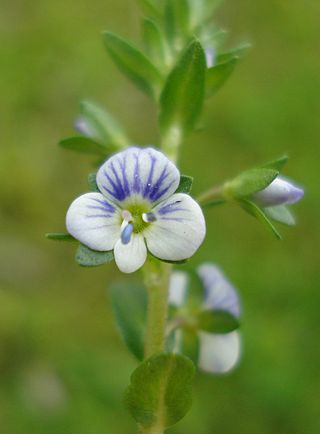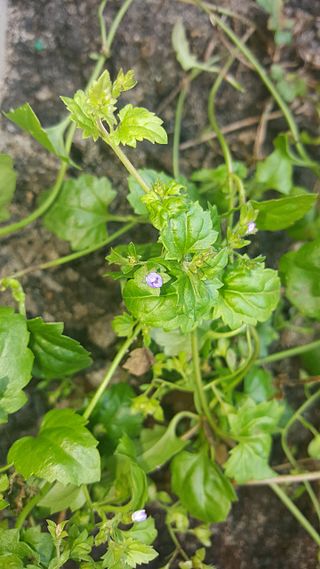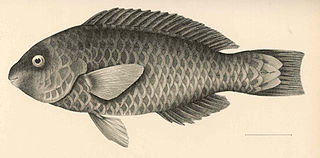
A pollinator is an animal that moves pollen from the male anther of a flower to the female stigma of a flower. This helps to bring about fertilization of the ovules in the flower by the male gametes from the pollen grains.

The longhorn beetles (Cerambycidae), also known as long-horned or longicorns, are a large family of beetles, with over 35,000 species described.

Rhodamine is a family of related dyes, a subset of the triarylmethane dyes. They are derivatives of xanthene. Important members of the rhodamine family are rhodamine 6G, rhodamine 123, and rhodamine B. They are mainly used to dye paper and inks, but they lack the lightfastness for fabric dyeing.

Veronica is the largest genus in the flowering plant family Plantaginaceae, with about 500 species. It was formerly classified in the family Scrophulariaceae. Common names include speedwell, bird's eye, and gypsyweed.

Clianthus puniceus, common name kaka beak, is a species of flowering plant in the genus Clianthus of the legume family Fabaceae, native to New Zealand's North Island.

The sheepshead minnow, also known as sheepshead pupfish, is a species of ray-finned fish in the family Cyprinodontidae, the pupfishes. It is found in salt marsh and estuary environments and is native to the eastern coasts of North and Central America.

β-Hydroxybutyryl-CoA is an intermediate in the fermentation of butyric acid, and in the metabolism of lysine and tryptophan. The L-3-hydroxybutyl-CoA enantiomer is also the second to last intermediate in beta oxidation of even-numbered, straight chain, and saturated fatty acids.

Veronica serpyllifolia, the thyme-leaved speedwell or thymeleaf speedwell, is a perennial flowering plant in the plantain family. It is native to Europe, but can be found elsewhere on most continents as an introduced species.
Neocallimastix patriciarum is a species of fungus that lives in the rumen of sheep and other ruminant species. N. patriciarum is an obligate anaerobe and is an important component of the microbial population within the rumen. Only one of a few rumen fungi, this species is interesting and unique within the fungal world. Originally thought to be a flagellate protists, species within the phylum Neocallimastigomycota were first recognized as a fungus by Colin Orpin in 1975 when he demonstrated that they had cell walls of chitin

Methyl 2-fluoroacrylate (MFA) is a chemical compound classified as an acrylate ester. The molecular formula is C4H5FO2 and the molecular weight is 104.08. The systematic name of this chemical is methyl 2-fluoroprop-2-enoate. It is used in industrial chemistry to produce acrylate polymers with mechanical and optical properties, and insect antifeedant 2-azabicyclo[2.1.1]hexane.

Veronica plebeia, commonly known as creeping- or trailing speedwell, is a species of flowering plant belonging to the family Plantaginaceae. It is native to Australia and New Zealand.
Paenarthrobacter histidinolovorans is a bacterium species from the genus Paenarthrobacter which has been isolated from soil. Paenarthrobacter histidinolovorans produces histidinol dehydrogenase.

Pterobilin also called biliverdin IXγ in the Fischer nomenclature, is a blue bile pigment found in Nessaea spp., Graphium agamemnon, G. antiphates, G. doson, and G. sarpedon. It is one of only a few blue pigments found in any animal species, as most animals use iridescence to create blue coloration. Other blue pigments of animal origin include phorcabilin, used by other butterflies in Graphium and Papilio, and sarpedobilin, which is used by Graphium sarpedon.

Elwira Lisowska is a Polish biochemist and professor. She made significant contributions to the biochemistry of human blood groups, especially MNS and P1PK blood group systems, and to the immunochemical characterization of glycopeptide antigens.

Veronica jovellanoides, commonly known as Riverhead speedwell, is a threatened flowering plant in the family Plantaginaceae. It is endemic to New Zealand, where only three plants are known in the wild. All are found within the Ernest Morgan Reserve, a 20 ha forest northwest of Auckland. Its discovery is accredited to a retired plant nursery owner, Geoff Davidson, who organised the land's protection a few decades prior, and found it by chance on a walk in November 2007.

AP-5 complex subunit mu (AP5M1), otherwise known as MUDENG (MuD), is a protein that is encoded by the AP5M1 gene. The AP5M1 gene was originally discovered when screening for genes which helped to promote death in Fas-mediated apoptosis. It is a highly conserved gene.

Scarus dubius, also known as regal parrotfish, is a parrotfish endemic to the Hawaiian Islands.

A pollinator garden is a type of garden designed with the intent of growing specific nectar and pollen-producing plants, in a way that attracts pollinating insects known as pollinators. Pollinators aid in the production of one out of every three bites of food consumed by humans, and pollinator gardens are a way to offer support for these species. In order for a garden to be considered a pollinator garden, it should provide various nectar producing flowers, shelter or shelter-providing plants for pollinators, and avoid the use of pesticides.
Miriam Margoth Martínez Díaz is a Colombian urban planner, human rights defender and civil engineer with a master's degree in administration from the Charles III University of Madrid. Currently she is candidate for mayor of Pasto.
















